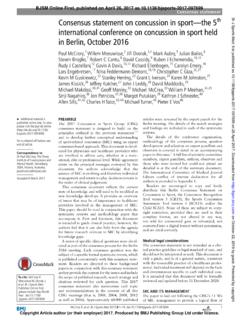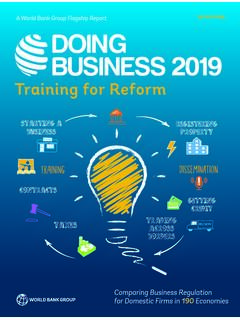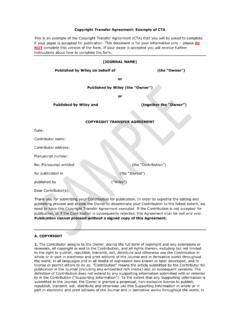Transcription of HTML & CSS
1 HTML & CSS: The Complete Reference, Fifth Edition About the Author Thomas A. Powell is a long-time industry veteran. After an early stint at CERFnet in the early 90s, he founded Powell Internet Consulting (later renamed PINT) in 1994, a Web design and consulting services firm. Today, PINT ( ) provides Web development, design, and consulting services to large and small corporations all over the United States in a variety of industries. Beyond his involvement at PINT, Thomas is heavily involved in the academic community. He developed the University of California, San Diego Extension Web Publishing program in the late 1990s and continues to teach classes there in Web development and design. He is also an instructor for the UCSD Computer Science Department, where he teaches classes in Web development and the theory of programming languages. Mr. Powell is well published, and his work has appeared in numerous trade publications. He continues to publish regularly in Network World.
2 He also has published numerous books on Web technology and design, including Ajax: The Complete Reference, JavaScript: The Complete Reference, and many others. His books have been translated into over 12 languages and are used around the world both in industry and college settings. About the Technical Editor James H. (Jim) Pence is a full-time writer, editor, speaker, singer, and performance chalk artist. Jim broke into book publishing in 2001 with How to Do Everything with HTML, a how-to book on Web authoring, written by a nontechie for nontechies, and published by McGraw-Hill Professional. He followed this book the same year with another book for McGraw-Hill: Cascading Style Sheets: A Beginner's Guide. McGraw-Hill published a second edition of Jim's HTML. book, re-titled How to Do Everything with HTML & XHTML, in 2003. Jim is also a published novelist. He is the author of Blind Sight (Tyndale, 2003), a suspense/thriller novel set in the mind-control cults, and The Angel (Kregel, 2006), set against the backdrop of the euthanasia and physician-assisted suicide movements.
3 Jim moved into true crime writing with his latest book, Terror by Night (Tyndale, 2009). Terror by Night is the true story of the brutal 2008 murders of the Caffey family in Emory, Texas. You can learn more about Jim's books and other creative projects at his Web site: HTML & CSS: The Complete Reference, Fifth Edition Thomas A. Powell New York Chicago San Francisco Lisbon London Madrid Mexico City Milan New Delhi San Juan Seoul Singapore Sydney Toronto Copyright 2010 by The McGraw-Hill Companies. All rights reserved. Except as permitted under the United States Copyright Act of 1976, no part of this publication may be reproduced or distributed in any form or by any means, or stored in a database or retrieval system, without the prior written permission of the publisher. ISBN: 978-0-07-174170-5. MHID: 0-07-174170-4. The material in this eBook also appears in the print version of this title: ISBN: 978-0-07-149629-2, MHID: 0-07-149629-7.
4 All trademarks are trademarks of their respective owners. Rather than put a trademark symbol after every occurrence of a trademarked name, we use names in an editorial fashion only, and to the benefit of the trademark owner, with no intention of infringement of the trademark. Where such designations appear in this book, they have been printed with initial caps. McGraw-Hill eBooks are available at special quantity discounts to use as premiums and sales promotions, or for use in corporate training programs. To contact a representative please e-mail us at Information has been obtained by McGraw-Hill from sources believed to be reliable. However, because of the possibility of human or mechanical error by our sources, McGraw-Hill, or others, McGraw-Hill does not guarantee the accuracy, adequacy, or completeness of any information and is not responsible for any errors or omissions or the results obtained from the use of such information.
5 TERMS OF USE. This is a copyrighted work and The McGraw-Hill Companies, Inc. ( McGraw-Hill ) and its licensors reserve all rights in and to the work. Use of this work is subject to these terms. Except as permitted under the Copyright Act of 1976 and the right to store and retrieve one copy of the work, you may not decompile, disassemble, reverse engineer, reproduce, modify, create derivative works based upon, transmit, distribute , disseminate, sell, publish or sublicense the work or any part of it without McGraw-Hill's prior consent. You may use the work for your own noncommercial and personal use; any other use of the work is strictly prohibited. Your right to use the work may be terminated if you fail to comply with these terms. THE WORK IS PROVIDED AS IS. McGRAW-HILL AND ITS LICENSORS MAKE NO GUARANTEES OR WARRANTIES AS TO THE. ACCURACY, ADEQUACY OR COMPLETENESS OF OR RESULTS TO BE OBTAINED FROM USING THE WORK, INCLUDING ANY. INFORMATION THAT CAN BE ACCESSED THROUGH THE WORK VIA HYPERLINK OR OTHERWISE, AND EXPRESSLY.
6 DISCLAIM ANY WARRANTY, EXPRESS OR IMPLIED, INCLUDING BUT NOT LIMITED TO IMPLIED WARRANTIES OF. MERCHANTABILITY OR FITNESS FOR A PARTICULAR PURPOSE. McGraw-Hill and its licensors do not warrant or guarantee that the functions contained in the work will meet your requirements or that its operation will be uninterrupted or error free. Neither McGraw-Hill nor its licensors shall be liable to you or anyone else for any inaccuracy, error or omission, regardless of cause, in the work or for any damages resulting therefrom. McGraw-Hill has no responsibility for the content of any information accessed through the work. Under no circumstances shall McGraw-Hill and/or its licensors be liable for any indirect, incidental, special, punitive, consequential or similar damages that result from the use of or inability to use the work, even if any of them has been advised of the possibility of such damages. This limitation of liability shall apply to any claim or cause whatsoever whether such claim or cause arises in contract, tort or otherwise.
7 Contents at a Glance Part I Core Markup 1 Traditional HTML and XHTML .. 3. 2 Introducing HTML5 .. 55. 3 HTML and XHTML Element Reference .. 133. Part II Core Style 4 Introduction to CSS .. 429. 5 CSS Syntax and Property Reference .. 521. 6 CSS3 Proprietary and Emerging Features Reference .. 613. Part III Appendixes A Character Entities .. 727. B Fonts .. 751. C Colors .. 765. D URLs .. 783. E Reading a Document Type De nition .. 801. Index .. 809. v This page intentionally left blank Contents Acknowledgments .. xxi Introduction .. xxiii Part I Core Markup 1 Traditional HTML and XHTML .. 3. First Look at HTML and XHTML .. 3. Hello HTML and XHTML World .. 6. Viewing Markup Locally .. 8. Viewing Markup with a Web Server .. 10. HTML and XHTML: Version History .. 14. HTML and XHTML DTDs: The Speci cations Up Close .. 16. Document Type Statements and Language Versions .. 18. (X)HTML Document Structure .. 20. The Document Head .. 23. The Document Body.
8 28. Browsers and (X)HTML .. 31. Validation .. 37. The Doctype Switch and Browser Rendering Modes .. 39. The Rules of (X)HTML .. 41. HTML Is Not Case Sensitive, XHTML Is .. 41. Attribute Values May Be Case Sensitive .. 42. (X)HTML Is Sensitive to a Single Whitespace Character .. 42. (X)HTML Follows a Content Model .. 43. Elements Should Have Close Tags Unless Empty .. 43. Unused Elements May Minimize .. 43. Elements Should Nest .. 43. Attributes Should Be Quoted .. 44. Entities Should Be Used for Special Characters .. 44. Browsers Ignore Unknown Attributes and Elements .. 44. Major Themes of (X)HTML .. 45. Logical and Physical Markup .. 45. Standards vs. Practice .. 46. Myths and Misconceptions About HTML and XHTML .. 47. The Future of Markup Two Paths? .. 49. XHTML: Web Page Markup XML Style .. 49. HTML5: Back to the Future .. 52. Summary .. 53. 2 Introducing HTML5 .. 55. Hello HTML5 .. 55. Loose Syntax Returns .. 58. XHTML5 .. 60.
9 Vii viii HTML & CSS: The Complete Reference HTML5: Embracing the Reality of Web Markup .. 62. Presentational Markup Removed and Rede ned .. 63. Out with the Old Elements .. 64. In with the New Elements .. 66. Sample of New Attributes for HTML5 .. 66. HTML5 Document Structure Changes .. 69. Adding Semantics .. 75. Marking Text .. 75. Indicating Dates and Time .. 76. Inserting Figures .. 76. Specifying Navigation .. 77. HTML5's Open Media Effort .. 78. <video> .. 78. <audio> .. 80. Media Considerations .. 82. Client-Side Graphics with <canvas> .. 82. Drawing and Styling Lines and Shapes .. 85. Drawing Arcs and Curves .. 90. Scaling, Rotating, and Translating Drawings .. 93. Using Bitmaps in Drawings .. 97. Text Support for canvas .. 98. <canvas> Conclusions .. 101. HTML5 Form Changes .. 101. New Form Field Types .. 101. Validating Data Entry .. 104. Autocomplete Lists .. 105. Miscellaneous Usability Improvements .. 105. Emerging Elements and Attributes to Support Web Applications.
10 106. menu Element Repurposed .. 106. command Element .. 108. meter and progress Elements .. 109. details Element .. 109. output Element .. 110. The Uncertain Future of Frames .. 110. The draggable Attribute and the Drag and Drop API .. 112. contenteditable Attribute .. 114. spellcheck Attribute .. 115. Internationalization Improvements .. 116. HTML5 Metadata Changes .. 116. data-X Attributes .. 116. Microdata .. 117. HTML5: Beyond Markup .. 120. defer Attribute .. 121. HTML, JavaScript, and the DOM Renewed .. 121. Standardizing and Extending Ad Hoc JavaScript Conventions .. 125. Major HTML5 Themes .. 126. HTML5 Today or Tomorrow? .. 126. HTML5 as a Catch-All .. 130. HTML5: Web Politics as Usual .. 131. HTML5: Imperfect Improvement .. 131. Summary .. 132. Contents ix 3 HTML and XHTML Element Reference .. 133. Flavors of HTML and XHTML .. 133. Core Attributes Reference .. 135. class .. 136. id .. 136. style .. 137. title .. 138. Language Attributes Reference.





